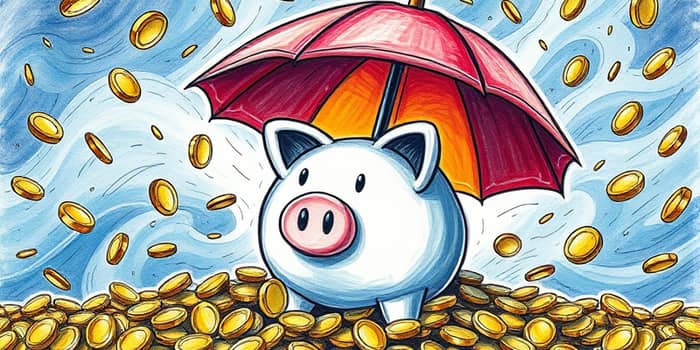When life throws unexpected challenges, having a robust backup can be the difference between security and stress. An emergency fund is more than just a rainy day safety net—it is a strategic tool to preserve your financial health, safeguard your goals, and maintain peace of mind when crises strike. In this comprehensive guide, you will learn what qualifies as an emergency, why you need a dedicated savings cushion, and how to build and maintain a fund that aligns with your unique needs.
Understanding Emergency Funds
An emergency fund is a dedicated savings account or cash reserve set aside to cover major, unexpected financial expenses. These may include job loss, medical bills, car repairs, or urgent home maintenance. By establishing a financial buffer to protect you from sudden expenses, you can navigate challenges without derailing your long-term financial plan or resorting to high-interest debt.
The primary purposes of an emergency fund are clear:
- Preventing reliance on high-interest debt for urgent needs.
- Offering peace of mind and financial security during turbulent times.
- Allowing you to pursue opportunities, like job changes or entrepreneurship, without compromising stability.
By committing to this disciplined approach, you will begin to see your inflation-resistant safety net grow, ready to support you when adversity strikes.
Identifying True Emergencies
Not every unforeseen expense should tap into your emergency fund. True emergencies are those that pose immediate risks to your well-being or financial stability. Examples include:
- Sudden job loss or a drop in income.
- Unexpected medical or dental bills.
- Major car or home repairs essential for safety.
- Urgent travel due to family crises.
Using your fund for impulse purchases or discretionary spending undermines its purpose. By reserving those dollars exclusively for genuine crises, you maintain long-term resilience in times of need.
Consider the difference between a flat tire and a vacation splurge. The former demands immediate attention; the latter can wait. By distinguishing essentials from desires, you preserve your fund’s integrity.
The Benefits of Having an Emergency Fund
Expanding on how this cushion transforms lives:
- It reduces financial anxiety and stress, knowing you have reserves to cover surprises.
- It minimizes debt accumulation, so you won’t rely on credit cards or loans at high interest rates.
- It empowers you with financial freedom and flexibility to pursue career moves or personal growth without fear.
- It prevents you from liquidating long-term investments at inopportune times, protecting your future wealth.
Picture a young professional, newly relocated, who loses their job. Instead of facing eviction or high-interest loans, they draw on their fund to cover rent and groceries, granting them the freedom to pursue the ideal next role rather than accept the first offer out of desperation. This is the power of financial freedom and flexibility.
Determining Your Savings Target
Experts generally recommend saving enough to cover three to six months of your essential living expenses. This guideline helps you weather both spending shocks (large, unexpected bills) and income shocks (job loss or reduced earnings). For instance, if your monthly costs are $3,000, aim for a fund between $9,000 and $18,000.
This milestone-based approach keeps you engaged and encouraged as you witness your progress. Plus, even a partial fund brings immediate relief—covering a small repair or a minor medical bill can prevent interest-laden debt and preserve your creditworthiness.
Factors Influencing Your Emergency Fund Size
In practice, adjust your calculations annually or whenever a major life event occurs. Marriage, a new child, or a career pivot could significantly increase your fixed costs. Conversely, paying off a car loan or securing a stable partner income may let you redirect some savings toward investments or other goals.
Essential Living Expenses
Understanding these categories in detail:
- Housing (rent or mortgage)
- Utilities (electricity, water, gas, internet)
- Food and groceries
- Transportation (fuel, insurance, repairs)
- Health insurance and basic medical bills
- Minimum debt payments
Review your bank statements and bills to confirm you’ve captured every necessary cost. Transparency with yourself is key to realistic planning.
Strategies to Build and Grow Your Emergency Fund
Establishing habits that stick:
- Set an initial milestone of $500 to $2,000 as a short-term safety net.
- Automate transfers from each paycheck to your fund.
- Increase contributions gradually as income grows or debts decrease.
- Halt discretionary spending until you hit your long-term target.
In addition to saving, look for ways to cut or redirect expenses. Unused subscriptions, impulse online shopping, and routine dining out can quietly gnaw away at your ability to save. By channeling that money directly into your fund, you transform everyday choices into powerful momentum toward security.
Another motivating tactic is finding a savings buddy or accountability partner. By checking in monthly to discuss progress, you reinforce commitment and share tips on overcoming hurdles.
Maintaining and Using Your Fund
When an emergency does occur, document each withdrawal and categorize the expense. This accounting practice not only ensures you’re using funds appropriately but also helps refine your future savings goals.
After you replenish your fund, consider raising your ongoing contributions by a small percentage—matching or exceeding any cost-of-living increases you experience.
U.S. Statistics and Inspiring Trends
Recent data show encouraging progress: in 2024, the share of American adults with at least three months of emergency savings rose steadily with age—39% for ages 18 to 29, 47% for those 30 to 44, 54% for ages 45 to 59, and 69% for individuals over 60. These figures underscore the universal importance of proactive planning, regardless of career stage.
These trends demonstrate that no matter where you fall on the age spectrum, building a cushion is achievable—and once established, fosters clarity and confidence. As more people witness the transformative benefits, emergency savings become not only a personal priority but a societal norm.
Synonyms and Mindset Shifts
Some prefer to call this resource a “rainy day fund” or a “contingency fund,” focusing on the mindset that life happens fund is not pessimistic—it is realistic. Embracing these phrases can reframe saving from a chore into an act of empowerment.
By viewing your fund as your insurance policy against anxiety and unexpected hardship, you shift from reactive scrambling to proactive peace of mind.
Embracing Financial Peace of Mind
Ultimately, the greatest value of an emergency fund is the mental clarity and reduced stress it affords. When you know your essentials are covered, you can approach life’s opportunities—and setbacks—with balanced perspective and resilience.
Start today by assessing your needs, setting a clear target, and taking one small action—automating a modest transfer, reviewing your expenses, or sharing your plan with a trusted friend. Each step builds momentum, guiding you toward lasting confidence in your financial journey.
References
- https://www.nerdwallet.com/article/banking/emergency-fund-why-it-matters
- https://investor.vanguard.com/investor-resources-education/emergency-fund/why-you-need-one
- https://www.mycvcu.org/blog/importance-of-building-an-emergency-fund
- https://corporatefinanceinstitute.com/resources/wealth-management/emergency-fund/
- https://www.investopedia.com/terms/e/emergency_fund.asp
- https://www.nerdwallet.com/article/banking/emergency-fund-calculator
- https://www.synchrony.com/blog/bank/what-is-an-emergency-fund
- https://www.newyorklife.com/articles/importance-of-emergency-fund










